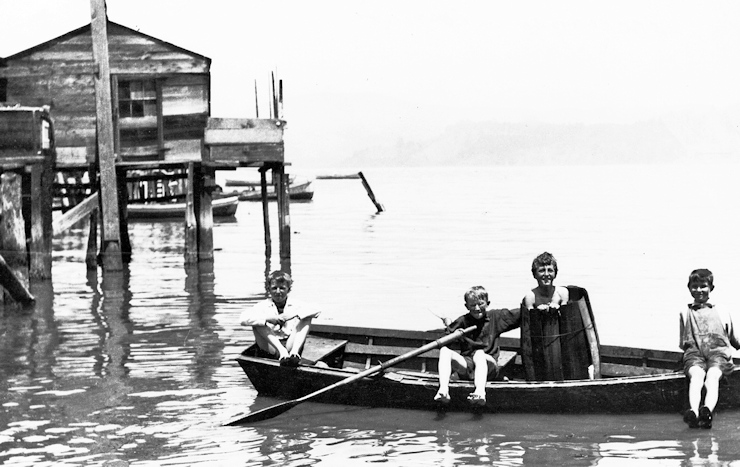
Donlon Arques is well known as the man who fostered Sausalito’s early houseboat community when he snapped up portions of the abandoned Marinship property and made them available to folks looking to live cheaply on the waterfront after World War II. But how did that come about? Arques was a very private individual, but Historical Society co–founder Phil Frank provided some insights into his background in his book, Houseboats of Sausalito. Here are some lightly edited excerpts:
Donlon and his brother Bub spent most of their early years on the Bay. Don described growing up on the water: “I was brought up as a kid on boats. I was broken in like that.” Beginning in 1913, the family operated several boatyards on the Sausalito waterfront.
During the 1910s and 1920s, wooden barges were being built by Don’s father, Camillo, at the Chrichton and Arques Shipyard at Napa Street. The barges were used both for commercial hauling of foodstuffs from the delta to San Francisco and for military purposes, per Arques’ Navy contracts.
In later years, Camillo and Don acquired a fleet of abandoned ferryboats, grain and vegetable barges, steam schooners, and piledrivers idled by the newly constructed bridges, highways, and trucks.
Camilo died in the 1940s and willed the yard (then at Johnson Street) to Don and Bub. Gates Three, Five, and Six similarly came under Don’s management. At these sites, scrapping operations recycled World War II materials and leftover craft from the ferry systems and bridges.
During World War II, Don Arques was contracted by the U.S. Navy to work at Marinship and at Terminal Island, San Pedro. He was one of the few individuals in Marin with the equipment and the ability to move the heavy material that needed relocation around the yard. He worked on contract until the yard was decommissioned in 1946. Arques later acquired surplus ships, shipyard land and equipment and began renting watercraft to artists and returning World War II soldiers. Ultimately, he would control much of the postwar Marinship property along the Sausalito waterfront.
Eventually, the County began threatening to demolish some of these non–code compliant dwellings, but they found a staunch adversary in Don Arques. County officials called him the “Howard Hughes of Sausalito” because of their difficulty reaching him, according to an article in the Wall Street Journal. Arques claimed that squatters had moved onto his property, “and I don’t pay any attention to them.” Yet the Journal pointed out, “he concedes that a few of them pay rent.”
Don died in 1993, after he and his wife Vera put their property at Gate 3 into a charitable educational trust and a maritime preservation foundation. When asked what he wanted to see there, Don replied, “marine enterprises, there’s so little left in the country.” It has operated that way ever since, but in the 1990s, developers gained control of the property, and have since put forth a variety of proposals to locate residential, office, mixed use and other non–water dependent developments along the waterfront.
In opposition, the Sausalito Working Waterfront Coalition of maritime craftsman, technology innovators, industrial craftsmen, artisans, and artists are advocating for an expanded maritime, artistic and industrial economic engine on the waterfront. This is the area where the recently closed Aquamaison, the only source of ferro–cement barges for our floating homes community, was located.